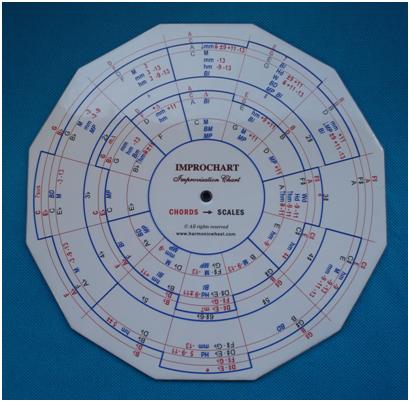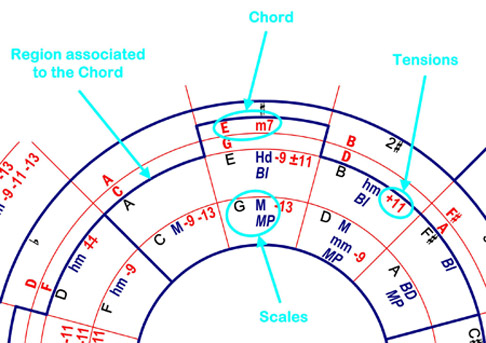|
3. IMPROCHART – IMPROVISATION CHART
There are in bibliography different books dealing with the improvisation subject, which indicate the most suitable scales for improvising over each chord. Nevertheless, these texts usually do not include the complete analysis for every key, but carry out the study for only one of them, leaving the reader its transposition to the rest of the keys. As it is easy to understand, all this amount of information is very difficult to memorize.
With the objective of sorting all this information in an easy way and including every key, a new abacus or Improvisation Chart, named IMPROCHART, has been developed. It consists of two rotating discs, one cardboard and the other plastic, and allows us to automatically obtain all the scales related to any chord (Fig. 2).

Figure 2. IMPROCHART – Improvisation Chart.
To obtain the most suitable scales for improvising on a given chord, simply rotate the plastic disc until the chord symbol matches the desired Root. For example, Fig. 3 shows the Em7 chord with its associated scales. Every chord type is assigned a region defined by blue lines, which inside has the scales related to the chord. As can be seen, the C M (Major), G M and D M scales are obtained, as well as B hm (harmonic minor) and D mm (melodic minor). The E Hd (Half-Whole diminished) scale also appears, although it is seldom used, along with the A BD (Bebop Dominant) scale and several Major Pentatonic (MP) and Blues (Bl) scales.
This way, a complete set of scales is available for improvising on this chord, where the choice of a particular one depends on the musical context and the performer’s will. The Bebop and Blues scales, for instance, are practically exclusive of these two kinds of music styles.

Figure 3. Obtaining the Scales associated to the Em7 Chord.
In the Improvisation Chart, 10 chord types are considered, along with their tensions, as well as 10 scale types. An equivalence table for other types of chords is also included. Moreover, with the aim of making the initiation to the improvisation easier and friendlier, a set of practical tables containing all these 10 scale types in every key is included. Finally, this instrument together with the scale tables, are designed in such a way that users do not necessarily need to know how to read music.
|